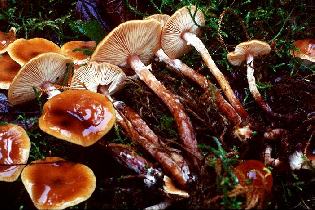en
names in breadcrumbs


Armillaria nabsnona can be identified most easily by its geographical distribution, primarily the west coast of North America, and host range, primarily on hardwoods in riparian areas, especially frequent on Alnus species. Macroscopic characters that may be used to distinguish A.nabsnona from other North American species include a more orange coloration when fresh and also a narrower stipe in comparison to the size of the pileus. The stipe is darker than other Armillaria species, especially when dried. There are no scales, but small black hairs may be present on the surface of the pileus, a similar situation to that found in A. mellea. Microscopically, Armillaria nabsnona can be distinguished from other western species of Armillaria by the pattern of branching of the basidia; the second basidium emerges from the clamp of the first, the third basidium emerging from the clamp of the second, and so on. This is particularly obvious in immature specimens, but often becomes obscured in more mature specimens as the basidia become larger and more closely packed together. Armillaria nabsnona has unbranched terminal cells in the cuticle of the pileus, distinguishing it from the similar A. mellea, which has frequently-branching terminal cells in the pileus cuticle. Armillaria mellea also lacks clamps at the bases of the basidia. Although it fruits much more commonly in the fall, Armillaria nabsnona is also the only Armillaria species so far found fruiting in the spring in the Pacific Northwest, although the frequency of this phenomenon is not known.
West coast of North America. Known from Washington, Oregon, California, British Columbia
Basidiomata tricholomatoid (Fig. 2-4). Pileus at first convex, later plane; 4-7 cm broad when fully expanded; surface smooth, hygrophanous, slimy-appearing when wet (Fig. 3), sometimes with short dark fibrils (“hairs”) on the disc when young; disc “snuff brown,” paler toward margins, often with darker irregular bruise-like areas on or near the surface; margin slightly incurved, “clay color,” translucent striate (striate appearance due to observation of gills through the thin flesh) to furrowed. Context 0.5-1 mm thick, white. Lamellae adnate to subdecurrent, subdistant, 0.75-1 mm wide, white to cream colored, darkening in age to pinkish-tan, often developing brownish patches. Stipe 8-10 cm long, 4-5 mm broad at base, narrowing to 2-3 mm broad at apex, “mummy brown” at base, paler “buckthorn brown” to “warm buff” at the annulus; with white cottony patches below the annulus; context white, fibrous, “peeling” away in parallel strips (as is typical for Armillaria species). Partial Veil in buttons dense white cottony until rupture; annulus flaring upward at first (Fig. 4), soon becoming ragged as the pileus expands, sometimes persisting as an evanescent cortina, but more often washed away and difficult to observe, sometimes completely lost upon drying. Rhizomorphs frequently lacking; when present, thick (1-2 mm broad), black, and branching.
Basidiospores white in mass; ovoid to subglobose; (6-)8-10 X 5.5-6.5 um, smooth, somewhat thick-walled at maturity, hyaline, negative in Melzer’s Reagent (Fig. 5). Basidia clavate; 25-35 X 5.5-6 um, 3-4 um broad just distal to clamped basal septum; four-sterigmate; sterigmata 4.5-6 um long at maturity, 1 um wide at base; with a clamp connection at base (Fig. 6); a second basidium usually forms from the basal clamp connection, sometimes with a third basidium developing from a clamp on the second (Fig. 7). This is most obvious in young incompletely expanded basidiomata. Cystidia not observed, but thin (2-3 um) wide hypha-like cells can sometimes be found among basidia. Pileipellis composed of swollen unbranched, hyaline, terminal cells, 40-60 X 14-16 um; with an underlying layer of more or less parallel, hyaline hyphae, 7-8 um wide (Fig. 8). Partial Veil composed of more or less parallel hyaline hyphae, 4-7 um diam, rarely branching, with frequent simple septa. Stipe Context composed of parallel and infrequently branching, simple septate, hyaline hyphae; elements 10-15 um wide, sometimes swollen in the mid-region. Stipitipellis of closely appressed, parallel, simple-septate, brown hyphae that frequently anastomose with H-connections between the parallel hyphae; elements 8-10 um broad, not swollen. Subhymenium with large clamp connections present on some hyphae (Fig. 9) especially on the 2-3 septa proximal to the basidia where hyphal branches proliferate directly from the clamps. Gill trama regular, hyphae usually simple septate, with occasional clamp connections.
Habit and Habitat. Gregarious, but not caespitose (Fig. 4), forming from branched black rhizomorphs or from 1 mm thick pseudosclerotial plates in the wood. Basidiomata have been found in both the fall (Sept.-Nov.) and the spring (April in Oregon).
Original Latin description: Fungiformi, pileo 4-5 cm diam, aurantio-brunneo; lamellis adnatis vel decurrentibus; stipite 8-10 cm X 2-5 mm, brunneo; velo supero, affixo 2-3 cm ab apice; contextu 0.5-1 mm lato; basidiis 25-35 × 5.5-6 m m, nodose-septatis; basidiosporis ovoideis vel subglobosis, (6-) 8-10 X 5.5-6.5 m m, inamyloideis; habitatio riparum, gregario ad lignum angiospermarum arborum.
Generally found in riparian areas, friting on dead hardwoods. Known from Maple (Acer_) and Alder (_Alnus). Apparently not pathogenic or only weakly so.
Other Armillaria species. See diagnostic description.
Some Armillaria species might also be confused with Pholiota species, but these have dark spores.

Edible mushroom. Most Armillaria species are considered to be delicious, especiallly in eastern Europe. To some they have a slight metallic taste. They are usually sort of firm and cartilaginous and are especially good in creamed soups.
This species is also important as a decomposer of wood in riparian areas, where the nutriens from the wood can be returned to the stream to be used by other kinds of organisms.